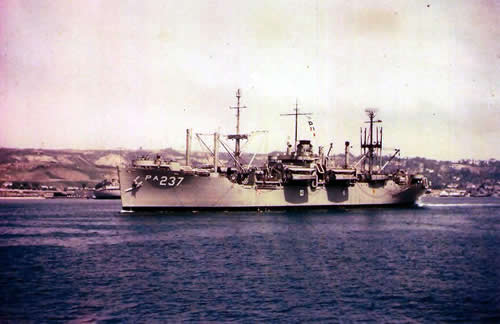
USS
Bexar Heading Out to Sea - San Diego, CA
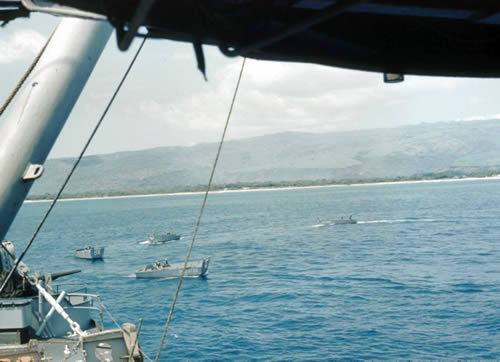
USS
Bexar - Assembly Circle
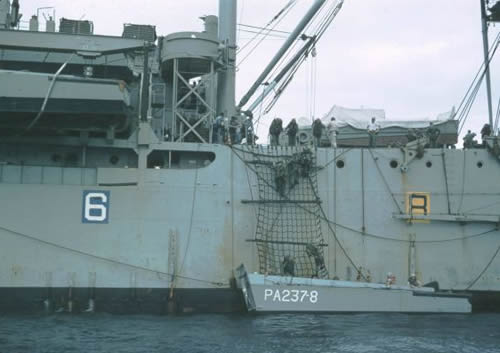
USS
Bexar - LCVP At Debark Station, Taking On Marines
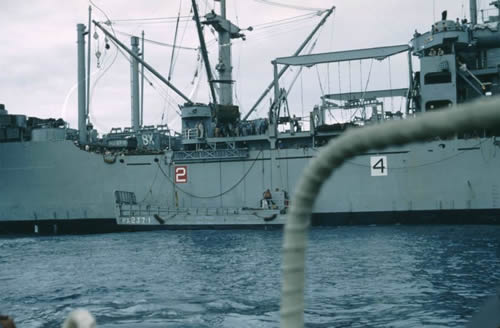
USS
Bexar - LCM Along Side
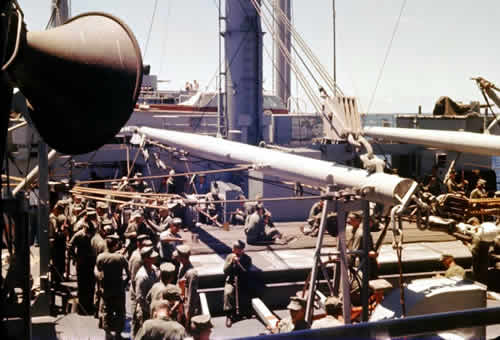
USS
Bexar - Marine Troops Around No. 2 Hatch
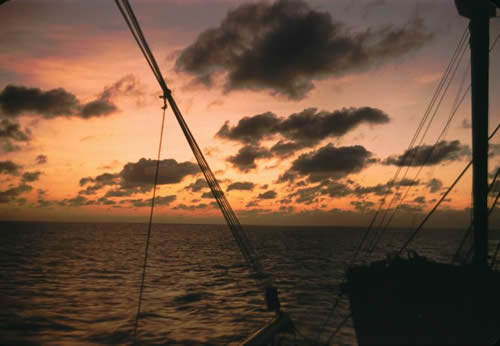
USS
Bexar - Sunset At Sea
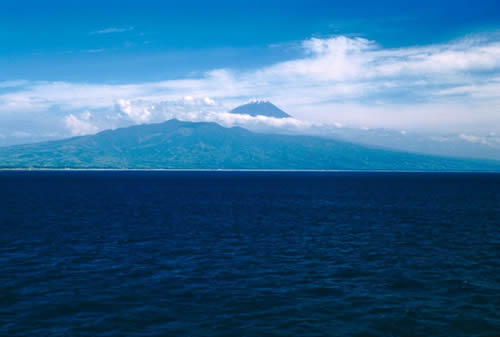
USS
Bexar - Mt. Fuji, Japan
Shore
Patrol experience . . . .
I
believe some of my worst experiences standing Shore Patrol occurred
during this deployment, primarily in Subic Bay, PI. I remember having
the inside (just inside the gate) Jeepney/Taxi stand during The USS
Bon Homme Richard's (CVA-31) last night in port (and a payday night
no less). I remember that just before midnight (when the gates close),
a stampede of several thousand drunk and unruly sailors came streaming
through the gates. And, most of them headed for the Jeepney/Taxi/Cattle-Car
stands just inside the gates - looking for a ride back to their ship.
I believe there were only four of us Shore Patrol personnel for the
only Jeepney/Taxi stand, and I was the senior guy. When it occurred
to all the drunks that there were only four of us, and only a limited
number of Jeepney's and Taxi's, well you can pretty much guess that
the situation became a little dicey (to say the least) rapidly. I
remember this CPO yelling at me and directing me to keep everyone
in an orderly line and not to take any guff off anyone. I said to
the CPO "I don't mean any disrespect Chief, but I'm not getting
myself killed trying to keep these drunks in line and if you feel
compelled to write me up, be my guest!" Well, I didn't get written
up and we did our best to keep everything as orderly as we could without
pissing anyone off (too much). I remember some of the junior Shore
Patrol personnel had to ride the Cattle-Cars (big passenger trailers
hooked to a semi) and many of them got the daylights stomped out of
them that night. The other unpleasant time I had on Shore Patrol was
riding the Grande Island boat. I learned the best way to stand that
duty was to take off your Shore Patrol brassard, hide your night stick,
and play like you're just one of the drunks. Later, as a CWO2 on the
Chicago, I was able to select (out of the duty group from all commands)
whom I wanted to walk my beat with - I picked the two biggest Marines
I could find.
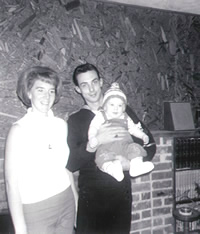
My Wife and son - After returning
from WestPac 1968.
Deployment
return . . . .
On September 20, 1968, after a long 8-month deployment,
we finally arrived back in San Diego. The ship was met by my wife,
new baby boy (Warren Jr., who was born just prior to our departure),
and my wife's parents. I had all my WestPac purchases laid out on
the pier and it looked like I was going to open my own retail store.
I think I brought back a set of china or silverware for every relative
my wife had - Ha! Not to mention all my stereo gear and our own china
and silverware sets, etc.
Sailor
of the Quarter . . . .
I
was voted "sailor-of-the-quarter" for Operations Department,
a few months after reporting aboard. I believe my appearance had a
lot to do with it as I always wore starched and pressed dungarees.
Being an ex-ship serviceman, I was used to wearing starched and pressed
uniforms.
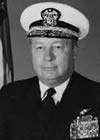
CO - Captain Forrest S. Peterson
Opinion
. . . .
Of
the ships I've been stationed on, I would have to say the Bexar is
not one of my favorites. We called it the Bexar Maru (pronouncing
it as it looks). Each morning, I would have to wrestle the cockroaches
over my shaving kit. Once in a while at night, a cockroach would run
over your face or body. The worst sound you could hear in the head,
was ggguuurrrrggglle! It meant the drains were backing up and you'd
better move fast! The sea water strainer in our berthing compartment
burst more than once, drenching us with sea water when we were sleeping
at night. We also had to chase down rats several times as they would
come aboard in the Marines' equipment when we carried Marines. Not
to mention chasing down a small pig, that 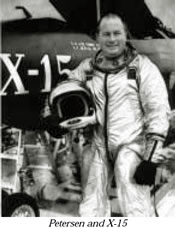 some
inebriated sailor won in a contest and brought on board in Hong Kong.
Then, there was the time I poured milk into my dry cereal and watched
it start moving! The food on board was the worst of my Navy career!
Our skipper was Captain F. S. Peterson (who later became the skipper
of the Enterprise and eventually went on to become a Vice Admiral).
He flew the X-15, I know, because he made (it wasn't voluntary) the
whole crew watch his home movies of him flying it. I believe he was
the only Navy pilot to fly the X-15 and he set many records during
his flights. The Bexar was a short stay before becoming CO of the
carrier Enterprise (he needed a deep draft command prior to taking
the helm of the Big "E" - I believe he was XO of the Enterprise
before taking command of the Bexar). My ex-brother-in-law was a new
CWO on the Enterprise when F.S. Peterson was the skipper and if I
remember right, he thought he was a pretty good skipper and liked
him.
some
inebriated sailor won in a contest and brought on board in Hong Kong.
Then, there was the time I poured milk into my dry cereal and watched
it start moving! The food on board was the worst of my Navy career!
Our skipper was Captain F. S. Peterson (who later became the skipper
of the Enterprise and eventually went on to become a Vice Admiral).
He flew the X-15, I know, because he made (it wasn't voluntary) the
whole crew watch his home movies of him flying it. I believe he was
the only Navy pilot to fly the X-15 and he set many records during
his flights. The Bexar was a short stay before becoming CO of the
carrier Enterprise (he needed a deep draft command prior to taking
the helm of the Big "E" - I believe he was XO of the Enterprise
before taking command of the Bexar). My ex-brother-in-law was a new
CWO on the Enterprise when F.S. Peterson was the skipper and if I
remember right, he thought he was a pretty good skipper and liked
him.
Why
is it that the Navy likes vaporizers so much? It must be a perquisite
for making Admiral, as several that I have served under, or have heard
of, made Admiral - i.e., USS Chicago's Capt Piotti and Cdr Reimann,
USS Bexar's Capt F.S. Peterson, USS Sunfish's Cdr Zack Pate, and others.
I'm sure the answer is because they bring results - even at the expense
of a lot of good people.
F.S. Peterson story . . . .
One time, while working on the
fathometer in the pilot house, I heard this ungodly loud screaming
and hollering coming from outside the porthole. Not thinking, I stuck
my head out (or as far as it would go anyway) the porthole to see
what the yelling was about. I ended up with my head right between
the skipper and an individual being chastised during a captain's mast
proceeding, being held on the bridge wing. I looked to the right at
the victim of the chewing out and then to my left, right into the
face of the skipper! I never moved so fast in my life! I was gone!
I stayed away from the bridge for a while.
CO's reefer . . . .
I remember we had an individual
in our division who would pick the lock on the old man's reefer when
coming back late off liberty and sit up in the shop eating baloney
sandwiches (which we also helped ourselves to). The old man never
did figure out who was stealing all his food.
Practical
jokes . . . .
We
were always playing practical jokes on someone. I remember that we
would take a Megger and charge up electrolytic Capacitors (or an old
PFN) and set them in the middle of the work bench and watch someone
get the daylights shocked out of them when picking one up. I also
remember one individual who did not like a bunk light on in the berthing
compartment after taps was announced. If they didn't heed his warning,
you would hear this loud "Zap" as he put this big screwdriver
(that he kept under his bunk) in his bunk light socket to short out
the circuit - which didn't get reset until the next morning.
I
remember one of the ET's playing a joke on a few Radiomen once. He
was awakened one night about a HF transmitter going down. He begrudgingly
stumbled up to the Radio Shack to examine this equipment casualty.
Upon examining the transmitter, he noticed it was just not tuned properly,
something the Radioman were trained and required to do. He states
" this is a pretty bad problem, so I'll go down to the shop to
get my toolbox and some spare parts." Upon his return, he opens
an equipment drawer and pretends to be troubleshooting the problem.
In the meantime he is replacing several vacuum tubes with some bad
tubes, that were in a box in the shop that we hadn't completed the
paperwork on yet. He closes up the Transmitter and says to the Radiomen
"it's back up and working." He goes back down to the berthing
compartment and hits his rack, but lays there knowing they'll be back
down to wake him again. It wasn't long before the Radiomen are shaking
him and reporting the transmitter is down again. He gets his tool
box, and the good tubes, and heads back to the Radio Shack. He opens
the transmitter drawer, pulls out a tube, lays it on the deck and
smashes it with a hammer! He holds it up to the light and says "yep,
that one's bad." He takes out another one and does the same thing.
In all, he did this three or four times, all in front of several astonished
radiomen! He then closed the equipment drawer, turned on the power,
tuned it properly and said "it's up and running."
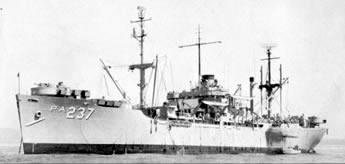
USS Bexar APA-237 At Anchor
New
ET Shop . . . .
The ET shop was a brand new compartment,
added on just before I came aboard. The real nice thing about it was
the huge new air conditioner - a real treasure on this tub. In the
heat of the summer, we lived in the place. We even slept in it when
it was unbearably hot down below in the berthing spaces. We spent
one miserable 3 month shipyard period in San Pedro, CA, in the middle
of a hot summer. The air conditioner was being worked on, so we couldn't
even use the shop because of the heat. We had to sleep in our regular
bunks, where the noise at night was unbearable. In addition, we would
be sleeping each night in sand and grit, from all the sandblasting
going on.
Other
ET's . . . .
One
assignment we had on board was maintaining the ship's entertainment
system. Every so often it would go dead because someone (usually in
officer's country) inadvertently would stick a pin through the radio
antenna cable running through the passageway overhead. Then they would
run a wire into their stateroom so they would have an antenna for
their radio. This one individual in our division, when discovering
one of these set-ups, would disconnect it and then pull real hard
on the wire going into the officer's stateroom. You could hear the
radio ricochet off the wall and floor. He never did get into trouble
for doing that. We also had a real ass.... for an operations boss.
When he left the ship, we presented him a plaque with a big screw
mounted on it. He said "I'm not sure how to take this?"
And our leading ET said "you can take it anyway you want sir!"
Transferred
to ETB School . . . .
Fortunately,
after eighteen months, I was able to exercise the option in my re-enlistment
contract to attend Advanced Electronics Class "B" School
at Treasure Island. I left the ship for ETB School in September of
1968.
The
USS Bexar APA-237 was decommissioned and transferred to The Mothball
Fleet 12/69.
Ranks
Attained:

Electronics Technician First Class
(I didn't find out that I had made ET1 until after arriving
at Treasure Island)
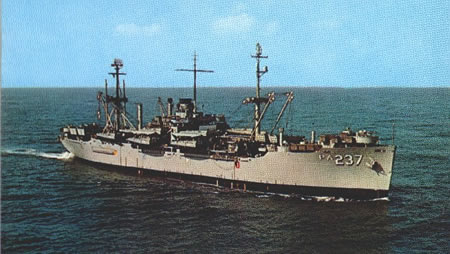
History
Of USS Bexar (APA-237)
Haskell
Class Attack Transport:
Displacement: 14,800 tons (full load)
Length: 455'
Beam: 62'
Draft: 28'
Speed: 16.5 knots
Armament: 1 5"/38 DP, 4x2 40mm, 1x4 40mm, 100 20mm
Complement: 532
Troops: 1,562
Capacity: 2 LCM(3), 21-22 LCVP, 1-2 LCP(L), 1 LCP(R)
Geared turbine engines, single screw, 8,500 hp
Built at Oregon Shipbuilding, and commissioned 9 October 2023
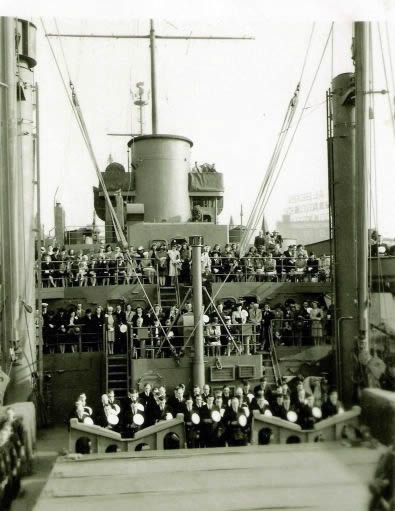
USS
Bexar APA-237 Commissioning Ceremony 9 Oct 2023
1945:
USS Bexar (APA-237) was commissioned and joined the Magic
Carpet Fleet. She participated in returning WWII troops home from
the Pacific theatre of action.
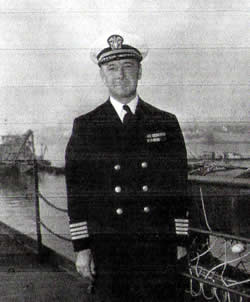
Capt. R.H. Wilcox - Bexar's first skipper
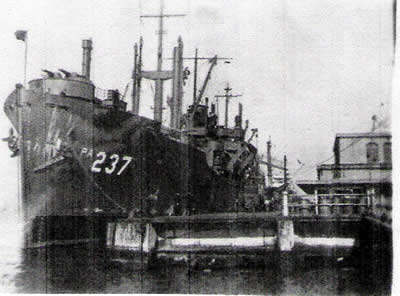
USS Bexar in port Yokosuka, Japan 1945
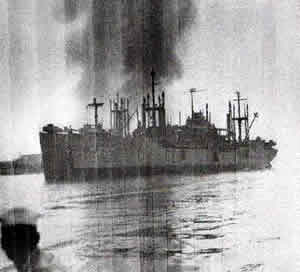
A bad fire that started on board USS Bexar and spread to ships alongside.
This fire caused something like $3,000,000.00 in total damages.
1946:
USS Bexar (APA-237) was ordered to Pearl Harbor to take part
in Operation Crossroads, the atomic bomb tests. In June she proceeded
to Bikini Atoll where she served as the flagship and equipment supply
support center in conjunction with that testing. In August USS Bexar
(APA-237) returned to the U.S. for radioactivity testing.
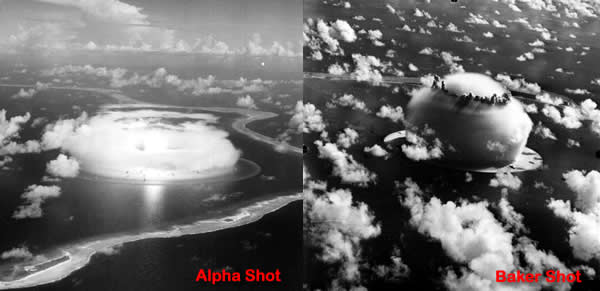
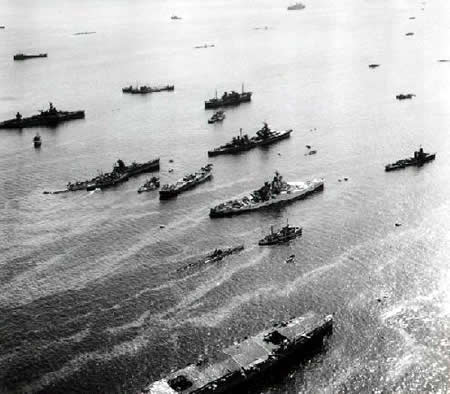
Atomic
Testing Fleet
1947:
USS Bexar (APA-237) was transferred to Commander Amphibious Forces
Atlantic, where she was based in Norfolk, VA.
1948:
USS Bexar (APA-237) embarked units of the 2nd Marines, at Morehead
City, N.C., for their deployment to Malta and subsequent transfer
to units of the 6th Fleet.
1949:
USS Bexar (APA-237) participated in amphibious Operation Miki in the
Hawaiian Islands. Then in December she participated in cold-weather
exercises, as part of COMTRANSDIV-22, along with the USS Fremont (APA-44),
USS Randall(APA-224) and the USS Colonial (LSD-20). In this era, between
WWII and the Korean War the Bexar won the coveted Meatball, a battle
efficiency pennant, on two separate occasions.
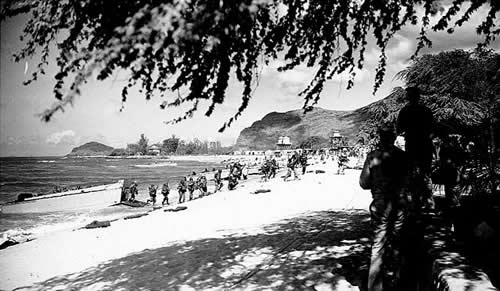
USS Bexar LCVP landing Marines during Operation Miki off Hawaii 1949
1950:
With hostilities in Korea commencing in June, she was ordered to Crete
in August 1950 and embarked Marines for the long trip to Japan via
the Suez Canal and then the Red Sea, India Ocean and the South China
Sea. Later in September and October Bexar participated in the Inchon
and Wonson landings in Korea and the evacuation of Chinnampo and Inchon.
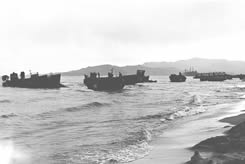
USS Bexar VP's and LCM's landing
troops during Korean War.
1951
- 1952:
The USS Bexar (APA-237) operated in various ports between Japan and
Korea rotating and landing troops, including those of the 5th Cavalry
Division and the 45th Division.
1953:
The USS Bexar (APA-237) arrived at Koji Do, Korea and assumed the
role of flagship in support of Operation Big Switch, the prisoner
movement from Koji Do to Inchon. By the time she left Korea in April
of 1955 the Bexar had received (3) Battle Stars.
1955:
The USS Bexar (APA-237) arrived at Ta’ Chen Islands and participated
in the evacuation of Chinese Nationalists to Formosa, taking over
3,000 refugees on board. Destination: KeeLung, Formosa.
1956:
The USS Bexar (APA-237) won the red ‘E’ for High Engineering
Efficiency.
1957:
The USS Bexar (APA-237) participated in Operation Strongback, a large
post-war amphibious exercise held in the Philippine Islands.
1958:
The USS Bexar (APA-237) won the Assault Boat Coxswain Award, the Battle
Efficiency Award and added a hash mark to her red ‘E’.
In October of that year she arrived in Seattle, WA. and took Army
troops on board for Operation Rocky Shoals.
1959:
The Bexar crew endured oppressive heat (to 108 degrees), working rare
‘tropical hours’ participating in Operation Saddle-Up,
landing Marines in Borneo.
1960:
The USS Bexar (APA-237) was in Pearl Harbor and joined in celebrating
the admission of Hawaii as the 50th State in the Union. Following
deployment to WestPac she responded to a request for emergency assistance
from the governor of Pangasinan Province, Luzon Is., Republic of the
Philippines. This was the first emergency landing in the fabled Lingayen
Gulf area since World War II and was a significant effort at aiding
the people of that province. Then in September she sailed to Djakarta,
Indonesia to receive President Sukarno and his wife and embarked 1,150
officers and men for transport to The Congo in support of a United
Nations mission to quell hostilities between the government forces
of President Mobutu and a contingency of rebels (many hired foreign
mercenaries) under the command of Tshombe and his provisional Katanga
government. By the time the Bexar returned back to her home port of
San Diego on 4 December, she had become the first US amphibious vessel
to circle the globe on one continuous voyage, logging in 27,828 miles
during 84 days total underway.
1961:
The USS Bexar (APA-237) earned her second consecutive Assault Boat
Coxswain Award. Later from October to November she participated in
Operation Silver Sword in the Hawaiian Islands.
1962:
The USS Bexar (APA-237) was part of Operation Tulangan in the Philippines,
off Mindoro Island. In November and December, she participated in
a huge operation to establish a blockade of Cuba, in dealing with
the Cuban Missile Crisis. For this effort she received the Armed Forces
Expeditionary Medal.
1963:
The USS Bexar (APA-237) participated in Operation Flagpole, a joint
exercise with forces of the Republic of Korea. Then late 1963 she
entered yards for extensive overhaul and modernization lasting for
five (5) months, anticipating actions in Vietnam.
1964:
The USS Bexar (APA-237) made her first mission to Vietnam. She provided
flood relief in Da Nang harbor area and embarked UDT teams as their
home-base for surveying of ‘Red Beach’ area for planned
February 1965 amphibious invasion.
1965:
The USS Bexar (APA-237) was back in Da Nang landing supplies and men
of the 7th fleet SLF (Special Landing Force) in conjunction with the
USS Thomaston (LSD-280). She then steamed north to participate in
the largest amphibious operation since the Korean War. She rendezvoused
with the USS Princeton (LPH-5), which served as launch vessel for
the SLF helicopter squadron.
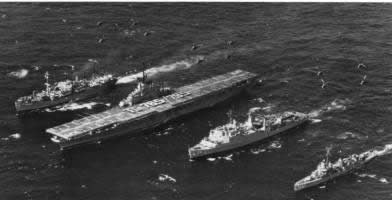
USS Bexar, USS Princeton, USS Thomaston, and unknown ship.
1966:
The USS Bexar (APA-237) departed San Diego enroute to Vietnam, via
Pearl Harbor, to deploy Marines. Later in July and August she disembarked
Company ‘H’, 2nd Battalion, 26th Marine Regiment in support
of 3rd Marine Division operation at Da Nang, Vietnam. As the war accelerated
she became engaged in amphibious operations off Okinawa with elements
of the 2nd Battalion, 4th Marine Division.
1967
- 1968:
The USS Bexar (APA-237) took on all new LCVPs and LCMs as part of
regularly scheduled yard overhaul. She transported troops and equipment
from Pearl Harbor to Da Nang, Vietnam and then took under aged Marines
to Okinawa. A Directive in effect at that time provided for a minimum
age for Marines in actual combat zones. She then proceeded to Yang
Po Rie, Korea for ‘wet net’ training of 5,000 Korean 5th
Division Marine troops. During the February-March TET of 1968, Bexar
embarked troops of the 1st Battalion, 29th Marine Division and convoyed
with the USS Washburn (AKA-108) and the USS Vancouver (LPD-2) to Da
Nang, Vietnam and then returned to Yang Po Rie to continue joint training
exercises. Late Spring and early Summer found Bexar anchored at Vung
Tau, Vietnam, 47 miles south of Saigon, as home-base support of River
Assault Squadrons 13 and 15 who were conducting assault incursions
up the tributaries of the Mekong River Delta area.
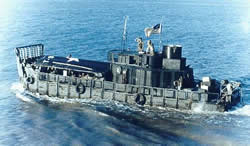
ATC
River Assault Craft
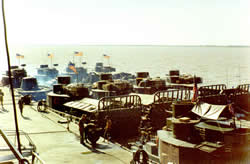
River Assault Boats - courtesy of
Don Blankenships site at rivervet.com
1969:
The USS Bexar (APA-237) once again participated in joint-training
exercise with elements of the South Korean Navy and Marines. In October
she departed for San Diego and was part of a joint Navy/Marine operation
named Keystone Cardinal. Upon arrival at San Diego she disembarked
1,400 marines and equipment.
December
15, 1969:
The USS Bexar (APA-237) was transferred, now with Hull designate LPA-237,
to Commander, Naval Inactive Ships Maintenance Facility (The Mothball
Fleet).
Awards
for Vietnam Service:
Navy Unit Commendation, RVN Gallantry Cross with Palm, RVN Campaign
Medal with 60's device and the Vietnam Service Medal with (5) Battle
Stars.
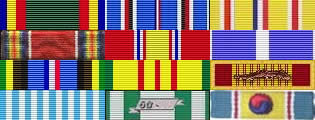
Precedence
of awards is from top to bottom, left to right
Top Row - Navy
Unit Commendation - American Campaign Medal - Asiatic-Pacific Campaign
Medal
Second Row -
World War II Victory Medal - National Defense Service Medal - Korean
Service Medal (3)
Third Row - Armed
Forces Expeditionary Medal (Congo, Cuba & Vietnam) - Vietnam
Service Medal - Republic of Vietnam Gallantry Cross Unit Citation
Fourth Row -
United Nations Service Medal - Republic of Vietnam Campaign Medal
- Republic of Korea War Service Medal

Please Sign My Guest Book





